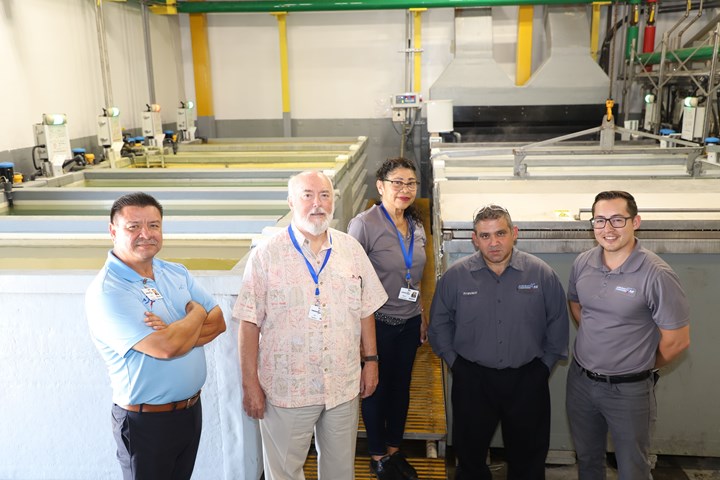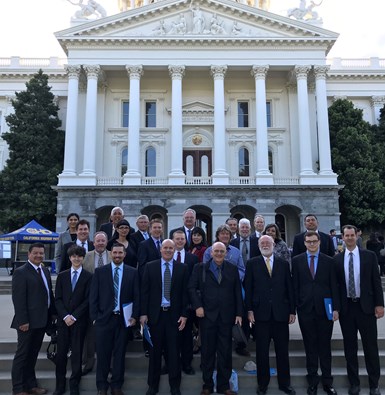The Continuing Battle Over Hex Chrome
The latest in the California regulatory battle over the phase-out of hexavalent chromium use in finishing operations.
#regulation

Aircraft X-Ray Laboratories is an outstanding example of a family finishing business. Photo: Aircraft X-Ray Laboratories
There is a fight going on in the finishing industry. This may sound dramatic, but for those involved, there are businesses and livelihoods on the line. Regulatory battles are certainly nothing new for the finishing industry. Changes in regulations come with each change in government and the conversations between business owners and lawmakers happen at both the federal and state levels. The latest bout for metal finishers in the state of California is over a proposed phase-out of the use of hexavalent chromium in metal finishing processes.
There have been several rounds of meetings to discuss a transition of the use of hexavalent chromium for both decorative and functional plating to alternative technologies — largely based on trivalent chromium technologies — within a relatively short time.
Featured Content
Currently, the deadlines proposed by the California Air Resources Board (CARB) are as follows:
- July 1, 2024, for decorative chromium plating,
- July 1, 2028, for functional chromium plating, and
- July 3, 2033, for chromic acid anodizing
Many of the processes affected by these technologies serve industries, such as aerospace and defense, where changing a technology or chemistry requires qualification of the new solution. Such changes take time to implement, and while CARB has extended its timelines by a couple of years since initial meetings and continues to review the transition timeframe, the deadlines are still seen as aggressive by many finishing operations.
A recent regulatory policy update issued by the National Association for Surface Finishers (NASF) states, “While CARB continues to extend the proposed timeframe for the transition, NASF and its California leadership have argued that the state’s regulatory deadlines remain unrealistic. If promulgated, this rule could have a significant adverse impact on platers in California and critical supply chains, particularly the U.S. defense supply chain.”
Jerry Desmond, who works as the legal advisor for the California chapters of the NASF, explains the predicament. “The processes covered by the hexavalent chromium (CrVI) Airborne Toxic Control Measure (ATCM) are critical to many industries and will continue to be provided in other states and countries. Decorative hex chrome plating is utilized for key segments of the consumer marketplace, while the aerospace and defense industries use hard chrome plating and chromic acid anodizing to meet strict OEM and defense [MIL-SPEC] requirements. It is estimated that 30% of contractors for the aerospace and defense sectors are located in California. The ability to meet these specifications is crucial to many supply chains.”
Desmond goes on to explain that rather than bans, the CrVI ATCM update should instead require actions to further reduce the negligible amount of air emissions of hexavalent chromium from metal finishing facilities.
“There is an effective alternative,” he says. “Metal finishing shops in Southern California are now investing significant capital to install and operate new measures as required by the recently-enacted South Coast Air Quality Management District [SCAQMD] Rule 1469 to further reduce emissions of hexavalent chromium.”

K&L Anodizing Corporation welcomes visitors at its annual tour. Photo: MFACA
Making some noise
The California Chapters of the National Association for Surface Finishers (NASF) — the Metal Finishing Association of Northern California (MFANC) and the Metal Finishing Association of Southern California (MFASC) have been orchestrating a letter-writing campaign to CARB members, state legislators, and customers regarding the negative impact the rule will have on surface finishing in California, as well as the California economy.

MFACA held Legislative Day on June 22-23 to alert the California Legislature. Photo: MFACA
The team leading the effort includes Bryan Leiker, executive director of the combined Metal Finishers Association of California (MFACA) and manager of K&L Anodizing (Burbank, Calif.); MFASC-MFANC California advocate Jerry Desmond; Justin Guzman, president of the MFASC and president of Aircraft X-Ray Laboratories (Los Angeles, Calif.); Bobbi Burns, president of MFANC and general manager of Global Plating Inc. (Fremont, Calif.); and Brian Ward, executive manager of AAA Plating & Inspection Inc. (Compton, Calif.) and technical strategist for the group. The team has had numerous meetings with CARB Board Members and its rule-making staff, including five working group meetings, and held an MFACA Legislative Day on June 22 -23 to alert the California Legislature.
The group’s efforts have helped persuade CARB to extend its proposed deadlines. According to Leiker, the next working group meeting will discuss the ruling with a deadline of 10 years for phasing out the use of hexavalent chromium use in decorative applications and 15 years for hard/functional chromium plating and chromic acid anodizing. This may seem like a victory, but the group sees any phase-out regardless of the timeline as unsatisfactory and continues to push for what it sees as a more realistic approach from CARB.
Desmond explains, “The bans do not change what the market requires, they will export these operations to other states and countries where there are often less, if any, controls. In addition to increasing air emissions, the bans will leak significant businesses and associated jobs away from California.”
The goal of MFACA is to return to the original solution of the AQMD Rule 1469, which at the time of its creation was supported by CARB.
Justin Guzman adds, “We’re pushing for an emissions-based rule, and not a phase-out — let’s come up with the numbers and give us the opportunity to get there.”
Leiker says that MFACA will continue to work with CARB on a fair, workable rule for all parties but will not support any rule that has a phase-out or ban.
“Our industry is less than one percent of hex chrome emissions in California,” he says. “Our ask is that CARB implements AQMD Rule 1469 statewide. Many years of work went into making 1469 a workable rule and CARB supported it.”
Get involved
The efforts of MFACA and the NASF have managed to buy surface finishers a bit more time. Yet the fight is far from over.
“As long as there's a ban on the table, whether it's a year, 10 years, it still creates uncertainty for the industry,” Leiker says. “If the rule passes, it could be just the nail in the coffin for businesses that have started contemplating relocating out of state.”
MFACA and the NASF say that it is critical for the industry that members of the finishing community participate in ongoing regulatory conversations — both concerning this ruling as well as other policy issues surrounding the industry.
Leiker points out, “If there was no association, this rule would have been signed, sealed and delivered in December and hexavalent decorative chrome would have been gone in a year from now.”
“We were very lucky that we engaged early on,” Guzman says. “We’re pushing back, but we still need help. We need support from those in the industry, the supply chain, and on the political side.”
Conversations concerning the CrVI ATCM continue with a final rule planned for mid-2022. The NASF has announced that in coordination with Department of Defense officials, it has scheduled a workshop on November 3, 2021, from 1:00 – 4:00 PM at SUR/FIN in Detroit, Michigan. NASF says “the workshop will include surface finishing industry experts and DOD officials and contractors who will focus on implications for the defense supply chain and identify approaches to address these implications from a technology and policy perspective.”
To learn more about how you can be involved visit mfaca.org
RELATED CONTENT
-
What Temperature Profiling System is Right for Me?
Today, profiling systems that are both sophisticated and easy to use can give a clear pass/fail finding, document regulatory compliance, let operators know when and where their ovens are trending out of acceptable limits or show that a process is within suppliers’ or customers’ specifications.
-
Is Your Electroplating Waste Hazardous?
Some that bears precious metals is, and there are a host of regulations to consider when recycling.
-
Best Plating Practices for the Application of Brush Plated Zinc-Nickel
Brush plating is an industrial electroplating process designed for demanding OEM and repair applications, without the use of an immersion tank. This presentation demonstrates the best practices for brush plating zinc-nickel to meet the ASTM standards of hydrogen embrittlement and corrosion protection. From preparatory steps to the application of a trivalent chromium conversion coating, the proper plating techniques needed to meet the customers’ demanding requirements are discussed.



















